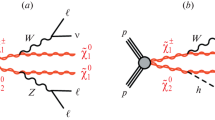Abstract
Relatively light sneutrinos, which are experimentally allowed, may significantly affect the currently popular search strategies for supersymmetric particles by decaying dominantly into an invisible channel. In certain cases the second lightest neutralino may also decay invisibly leading to two extra carriers of missing energy — in addition to the lightest supersymmetric particle (LSP)\(\tilde Z_1 \) — the effective LSPs (ELSPs). It is shown that these ELSPs are allowed in supergravity models with common scalar and gaugino masses at the unification scale for a sizable region of parameter space and are consistent with all constraints derived so far from SUSY searches. The pair production of right handed sleptons, which can very well be the lightest charged SUSY particles in this scenario, at LEP 200 and their decay signatures are discussed. The signal survives kinematical cuts required to remove the standard model background. Charginos are also pair produced copiously if kinematically accessible; they also decay dominantly into hadronically quiet di-lepton +\(\not E_T \) modes leading to interesting unlike sign dilepton events which are again easily separable from the Standard Model backgrounds at LEP 200 energies.
Similar content being viewed by others
References
For a review see, for example, H. Haber, G. Kane: Phys. Rep. 117 (1985) 75
A. Datta, B. Mukhopadhyaya, M. Guchait: preprint MRI-PHY-11/93, to appear in Mod. Phys. Lett. A
Some aspects of ELSPs in the context of SUSY searches at hadron colliders have been considered by H. Baer, C. Kao, X. Tata: Phys. Rev. D48 (1993) R2978; M. Barnett, J. Gunion, H. Haber: Phys. Lett. B315 (1993), 349; and at high energye + e − linear colliders by J.F. Grivaz, Proceedings of the Workshope + e − Collisions at 500 GeV: The Physics Potential, DESY report 92–123B (Ed. P.M. Zerwas)
CDF collaboration, F. Abe: et al., Phys. Rev. Lett. 69 (1992) 3439
M. Chen, C. Dionisi, M. Martinez, X. Tata: Phys. Rep. 159 (1988) 201
See, for example, H. P. Nilles, Phys. Rep. 110 (1984) 1
Particle Data Group, Phys. Rev. D50, 1173 (1994)
A. Bartl, H. Fraas, W. Majerotto: Z. Phys. C34 (1987) 411
A. Bartl, H. Fraas, W. Majerotto: Z. Phys. C30, (1986) 441
See, for example, V. Barger and R.J.N. Phillips, Collider Physics, (Addison-Wesley, 1987) and references therein
S. Chakrabarti, A. Datta, M. Guchait: ICTP preprint IC/94/303 (1994), to appear in Z.Phys. C
A. Datta, A. Datta, S. Raychaudhuri: Phys. Lett. B349, 113 (1995)
Author information
Authors and Affiliations
Rights and permissions
About this article
Cite this article
Datta, A., Guchait, M. & Drees, M. Hunting effective LSPs at LEP 200. Z. Phys. C - Particles and Fields 69, 347–357 (1995). https://doi.org/10.1007/BF02907415
Received:
Revised:
Issue Date:
DOI: https://doi.org/10.1007/BF02907415



